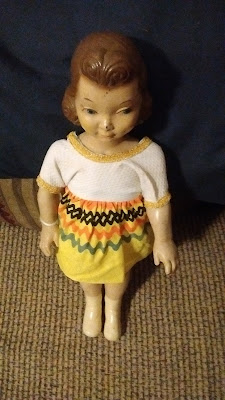Many of us in the doll business are often loathe to collect a doll or figurine that has been repaired. Like Barbara Pym's Leonora Eyre of The Sweet Dove Died, we don't' want imperfection in our lives. She hides a hand painted glass pitcher, formerly one of her treasures, because she notices a tiny chip in the paint of one of the flowers.
The whole point of antique and vintage dolls, at least, is that they are used nad well-loved. Look at the "as is" disclaimers that go with them when you buy them on e-bay.
More than that, however, is the history and patina that these dolls have. They have been loved; they shouldn't be disguised or repaired to he point of perfection. I don't think they should be disdained, either. I'm not alone in that, or there would be no doll hospitals or books on doll repair.
Others who collect with money to burn still buy objects in need of a little TLC. Doris Duke had a studio in one of her estates where she had all the broken china sent. She mended it as a hobby. Marilyn Gelfman Karp in her classic In Flagrante Collecto describes "poignant repairs" among her favorite collectibles. These are pieces of pottery repaired with nails and braces of wood and other materials. they are hard to find. I have only one example among my treasures.
Ever since I read of Beth March and her pathetic collection of rag tag dolls that she nursed and cherished, I've had a special place in my heart for the misfit dolls that need help. Some are the best examples I could find of rare dolls, but others were dolly wrecks that needed a new life.
I do some of my own repairs, but would no way work on someone else's dolls. As I wrote for an About.com article, "I'm not a Doll Doctor, But . . . .", I had means of repairing and maintaining my dolls, of dressing them and constructing bodies, without doing any harm. It could all be undone.
One famous collector dealer I crossed paths with in San Jose used to buy the repainted and professionally repaired French bisque doll heads and then remove the paint. He showed me how he did this with a Jumeau head.
He had mint French Fashions and Bebes in his collection that were mint and very rare, but he had a soft spot for rescuing the less than perfect among them, too.
Many current mixed media artists see the beauty in these fabulous fragments; they create jewelry, vignettes, and all sorts of art from them. As a result, doll parts are selling briskly and books on assemblage and collage using antique and vintage doll parts pop up everywhere. I have written on these artists, too, including a post called "Fabulous Fragments."
Good dolls in mint shape are hard to come by; I never advocate to collect for investment; doing so makes us doll snobs with tunnel vision. That's just my opinion. I go with buy what you like and what inspires you. You will still have a valuable collection, but you will enjoy it for its intrinsic self.
Dolls have their own history; those who are banged up have the best stories to tell. Some little girl loved them; they provided comfort and companion ship. Also, many dolls would not be saved if we only wanted mint examples, the "failures" of the play world.
For a while, collectors wanted Barbies out of the box, and one famous photographer only collects the undressed, played with variety. Read about her in M.G. Lord's, Forever Barbie.
Old dolls are finite; they are no longer made. Preserving them in any condition tell us about the business history of the toy industry, of materials used, of manufacturing practices and cultural norms.
One famous author even stated that every old doll is rare. That's true. Real antiques, even "low brow" china heads, are disappearing from antique malls and stores.
Back to Kintsugi; no one is perfect, everything is flawed. Read Plato for more on the theory, or Derrida on the idea of signs in the post modern world. Yet, it is our flaw that give us history. If old pottery and china are worth saving through Kintsugi, so are old dolls.



















No comments:
Post a Comment